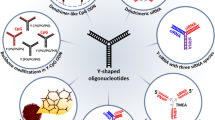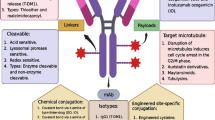No Heading
Purpose.
Tumor-targeting prodrugs of 5-fluoro-2′-deoxyuridine (5-FdUrd), which are chemical conjugations of 5-FdUrd with a tumor-homing cyclic peptide CNGRC by succinate and glutarate linkers, were synthesized to investigate the structural effects of linkers on the hydrolytic release of 5-FdUrd and the tumor-cell–selective cytotoxicity.
Methods.
A solid phase synthesis method was used to produce 5-FdUrd prodrugs. The kinetics and efficiency of hydrolytic 5-FdUrd release from the prodrugs were investigated in phosphate buffer (PB), fetal bovine serum (FBS), HT-1080 cell lysate, MDA-MB-231 cell lysate, and MEM containing 10% FBS. The tumor-cell–selective cytotoxicity of prodrugs was evaluated by an MTT method.
Results.
Two tumor-targeting prodrugs CNF1 and CNF2 bearing 5-FdUrd conjugated with a common cyclic peptide CNGRC by succinate and glutarate linkers, respectively, and their control compounds CN1 and CN2 without 5-FdUrd moiety were synthesized and identified. CNF1 underwent hydrolysis to release 5-FdUrd more rapidly and efficiently than CNF2. Both prodrugs were of lower cytotoxicity compared to 5-FdUrd, showing more selective cytotoxicity toward APN/CD13 positive cells (HT-1080) than toward APN/CD13 negative cells (HT-29, MDA-MB-231).
Conclusions.
A new class of tumor-targeting 5-FdUrd prodrugs CNF1 and CNF2 were successfully synthesized. These prodrugs targeted a tumor marker APN/CD13 to cause tumor-cell–selective cyctotoxicity due to 5-FdUrd release, the rate of which could be controlled by the structure of ester linker.
Similar content being viewed by others
References
1. E. Chu, A. Mota, and M. C. Fogarasi. Pharmacology of cancer chemotherapy. In V. T. DeVita, S. Hellman and S. A. Rosenberg (eds.), Cancer Principles & Practice of Oncology, 6th ed., Vol. 1, Lippincott Williams & Wilkins: Philadelphia, 2001, pp. 388–415.
2. C. E. Myers. The pharmacology of the fluoropyrimidines. Pharmacol. Rev. 33:1–15 (1981).
3. J. A. van Laar, Y. M. Rustum, S. P. Ackland, C. J. van Groeningen, and G. J. Peters. Comparison of 5-fluoro-2′-deoxyuridine with 5-fluorouracil and their role in the treatment of colorectal cancer. Eur. J. Cancer 34:296–306 (1998).
4. S. Fukushima, T. Kawaguchi, M. Nishida, K. Juni, Y. Yamshita, M. Takahashi, and M. Nakano. Selective anticancer effects of 3′,5′-dioctanoyl-5-fluoro-2′-deoxyuridine, a lipophilic prodrug of 5-fluoro-2′-deoxyuridine, dissolved in an oily lymphographic agent on hepatic cancer of rabbits bearing VX-2 tumor. Cancer Res. 47:1930–1934 (1987).
5. B. S. Vig, P. J. Lorenzi, S. Mittal, C. P. Landowski, H. Shin, H. Mosberg, J. M. Hilfinger, and G. L. Amidon. Amino acid ester prodrugs of fluorodeoxyuridine: synthesis and effects of structure, stereochemistry, and site of esterification on rate of hydrolysis. Pharm. Res. 20:1381–1388 (2003).
6. Z. Xia, L. I. Wiebe, G. G. Miller, and E. E. Knaus. Synthesis and biological evaluation of butanoate, retinoate, and bis(2,2,2-trichloroethyl)phosphate derivatives of 5-fluoro-2′-deoxyuridine and 2′,5-difluoro-2′-deoxyuridine as potential dual action anticancer prodrugs. Arch. Pharm. (Weiheim) 332:286–294 (1999).
7. K. Tanabe, Y. Mimasu, A. Eto, Y. Tachi, S. Sakakibara, M. Mori, H. Hatta, and S. Nishimoto. One-electron reduction characteristics of N(3)-substituted 5-fluorodeoxyuridines synthesized as radiation-activated prodrugs. Bioorg. Med. Chem. 11:4551–4556 (2003).
8. Y. Shibamoto, Y. Tachi, K. Tanabe, H. Hatta, and S. Nishimoto. In vitro and in vivo evaluation of novel antitumor prodrugs of 5-fluoro-2′-deoxyuridine activated by hypoxic irradiation. Int. J. Radiat. Oncol. Biol. Phys. 58:397–402 (2004).
9. Y. Wei, Y. Yan, D. Pei, and B. Gong. A photoactivated prodrug. Bioorg. Med. Chem. Lett. 8:2419–2422 (1998).
10. G. A. Koning, J. A. Kamps, and G. L. Scherphof. Efficient intracellular delivery of 5-fluorodeoxyuridine into colon cancer cells by targeted immunoliposomes. Cancer Detect. Prev. 26:299–307 (2002).
11. G. A. Koning, A. Gorter, G. L. Scherphof, and J. A. Kamps. Antiproliferative effect of immunoliposomes containing 5-fluorodeoxyuridine-dipalmitate on colon cancer cells. Br. J. Cancer 80:1718–1725 (1999).
12. A. Goerlach, K. G. Krauer, I. F. McKenzie, and G. A. Pietersz. In vitro antitumor activity of 2′-deoxy-5-fluorouridine-monoclonal antibody conjugates. Bioconjug. Chem. 2:96–101 (1991).
13. D. C. Drummond, O. Meyer, K. Hong, D. B. Kirpotin, and D. Papahadjopoulos. Optimizing liposomes for delivery of chemotherapeutic agents to solid tumors. Pharmaco. Rev. 51:691–743 (1999).
14. S. K. Hobbs, W. L. Monsky, F. Yuan, W. G. Roberts, L. Griffith, V. P. Torchilin, and R. K. Jain. Regulation of transport pathways in tumor vessels: role of tumor type and microenvironment. Proc. Natl. Acad. Sci. USA 95:4607–4612 (1998).
15. I. Brigger, C. Dubernet, and P. Couvreur. Nanoparticles in cancer therapy and diagnosis. Adv. Drug Deliv. Rev. 54:631–651 (2002).
16. P. D. Senter and C. J. Springer. Selective activation of anticancer prodrugs by monoclonal antibody-enzyme conjugates. Adv. Drug Deliv. Rev. 53:247–264 (2001).
17. E. C. Ko, X. Wang, and S. Ferrone. Immunotherapy of malignant diseases. Challenges and strategies. Int. Arch. Allergy Immunol. 132:294–309 (2003).
18. E. Ruoslahti. Specialization of tumor vasculature. Nat. Rev. Cancer 2:83–90 (2002).
19. P. Alessi, C. Ebbinghaus, and D. Neri. Molecular targeting of angiogenesis. Biochim. Biophys. Acta 1654:39–49 (2004).
20. E. Ruoslahti and D. Rajotte. An address system in the vasculature of normal tissues and tumors Annu. Rev. Immunol. 18:813–827 (2000).
21. R. Pasqualini and E. Ruoslahti. Organ targeting in vivo using phage display peptide libraries. Nature 380:364–366 (1996).
22. K. Porkka, P. Laakkonen, J. A. Hoffman, M. Bernasconi, and E. Ruoslahti. A fragment of the HMGN2 protein homes to the nuclei of tumor cells and tumor endothelial cells in vivo. Proc. Natl. Acad. Sci. USA 99:7444–7449 (2002).
23. L. A. Landon and S. L. Deutscher. Combinatorial discovery of tumor targeting peptides using phage display. J. Cell. Biochem. 90:509–517 (2003).
24. W. Arap, R. Pasqualini, and E. Ruoslahti. Cancer treatment by targeted drug delivery to tumor vasculature in a mouse model. Science 279:377–380 (1998).
25. M. Trepel, W. Arap, and R. Pasqualini. In vivo phage display and vascular heterogeneity: implications for targeted medicine. Curr. Opin. Chem. Biol. 6:399–404 (2002).
26. R. Pasqualini, E. Koivunen, R. Kain, J. Lahdenranta, M. Sakamoto, A. Stryhn, R. A. Ashmun, L. H. Shapiro, W. Arap, and E. Ruoslahti. Aminopeptidase N is a receptor for tumor-homing peptides and a target for inhibiting angiogenesis. Cancer Res. 60:722–727 (2000).
27. F. Curnis, G. Arrigoni, A. Sacchi, L. Fischetti, W. Arap, R. Pasqualini, and A. Corti. Differential binding of drugs containing the NGR motif to CD13 isoforms in tumor vessels, epithelia, and myeloid cells. Cancer Res. 62:867–874 (2002).
28. H. Tamamura, A. Omagari, K. Hiramatsu, T. Kanamoto, K. Gotoh, K. Kanbara, N. Yamamoto, H. Nakashima, A. Otaka, and N. Fuji. Synthesis and evaluation of biofunctional anti-HIV agents based on specific CXCR4 antagonist-AZT conjugation. Bioorg. Med. Chem. 9:2179–2187 (2001).
29. A. Nagy, A. Polnowski, and A. V. Schally. Stability of cytotoxic luteinizing hormone-releasing hormone conjugate (AN-152) containing doxorubicin 14-O-hemiglutarate in mouse and human serum in vitro: implications for the design of preclinical studies. Proc. Natl. Acad. Sci. USA 97:829–834 (2000).
30. H. Tamamura, T. Ishihara, H. Oyake, M. Imai, A. Otaka, T. Ibuka, R. Arakaki, H. Nakashima, T. Murakami, M. Waki, A. Matsumoto, N. Yamamoto, and N. Fujii. Convenient one-pot synthesis of cystine-containing peptides using the trimethylsilyl chloride-dimethyl sulfoxide/trifluoroacetic acid system and its application to the synthesis of bifunctional anti-HIV compounds. J. Chem. Soc., Perkin Trans. 1 1:495–500 (1998).
31. T. Mosmann. Rapid colorimetric assay for cellular growth and survival: application to proliferation and cytotoxicity assays. J. Immunol. Methods 65:55–63 (1983).
32. Y. Shibamoto, Y. Mimasu, Y. Tachi, H. Hatta, and S. Nishimoto. Comparison of 5-fluorouracil and 5-fluoro-2′-deoxyuridine as an effector in radiation-activated prodrugs. J. Chemother. 14:390–396 (2002).
33. Y. van Hensbergen, H. J. Broxterman, Y. W. Elderkamp, J. Lankelma, J. C. Beers, M. Heijn, E. Boven, K. Hoekman, and H. M. Pinedo. A doxorubicin-CNGRC-peptide conjugate with prodrug properties. Biochem. Pharmacol. 63:897–908 (2002).
34. J. S. Shim, J. H. Kim, H. Y. Cho, Y. N. Yum, S. H. Kim, H. J. Park, B. S. Shim, S. H. Choi, and H. J. Kwon. Irreversible inhibition of CD13/aminopeptidase N by the antiangiogenic agent curcumin. Chem. Biol. 10:695–704 (2003).
35. D. Riemann, A. Kehlen, K. Thiele, M. Löhn, and J. Langner. Induction of aminopeptidase N/CD13 on human lymphocytes after adhesion to fibroblast-like synoviocytes, endothelial cells, epithelial cells, and monocytes/macrophages. J. Immunol. 158:3425–3432 (1997).
36. F. Curnis, A. Sacchi, L. Borgna, F. Magni, A. Gasparri, and A. Corti. Enhancement of tumor necrosis factor alpha antitumor immunotherapeutic properties by targeted delivery to aminopeptidase N (CD13). Nat. Biotechnol. 18:1185–1190 (2000).
37. W. Arap, M. G. Kolonin, M. Trepel, J. Lahdenranta, M. Cardo-Vila, R. J. Giordano, P. J. Mintz, P. U. Ardelt, V. J. Yao, C. I. Vidal, L. Chen, A. Flamm, H. Valtanen, L. M. Weavind, M. E. Hicks, R. E. Pollock, G. H. Botz, C. D. Bucana, E. Koivunen, D. Cahill, P. Troncoso, K. A. Baggerly, R. D. Pentz, K. A. Do, C. J. Logothetis, and R. Pasqualini. Steps toward mapping the human vasculature by phage display. Nat. Med. 8:121–127 (2002).
38. F. Pastorino, C. Brignole, D. Marimpietri, M. Cilli, C. Gambini, D. Ribatti, R. Longhi, T. M. Allen, A. Corti, and M. Ponzoni. Vascular damage and anti-angiogenic effects of tumor vessel-targeted liposomal chemotherapy. Cancer Res. 63:7400–7409 (2003).
Author information
Authors and Affiliations
Corresponding author
Rights and permissions
About this article
Cite this article
Zhang, Z., Hatta, H., Tanabe, K. et al. A New Class of 5-Fluoro-2′-deoxyuridine Prodrugs Conjugated with a Tumor-Homing Cyclic Peptide CNGRC by Ester Linkers: Synthesis, Reactivity, and Tumor-Cell–Selective Cytotoxicity. Pharm Res 22, 381–389 (2005). https://doi.org/10.1007/s11095-004-1875-x
Received:
Accepted:
Published:
Issue Date:
DOI: https://doi.org/10.1007/s11095-004-1875-x




